►Maserati takes the fight to Bentley
► Conti GTC Speed vs GranCabrio Trofeo
► Two grand convertibles take on northern England
This isn’t Beatrix Potter’s Cumbria of woodland paths, chatty rabbits and tourist coaches grinding by like plate tectonics. We’re exploring the county’s harder, more remote north-eastern corner, where peaty moors devour men whole if they stop to take in the view, and where a typical two-vehicle combination would be a quad bike and a battle-scarred old Land Rover Defender.
The Bentley Continental GTC Speed and Maserati GranCabrio Trofeo might be conspicuously out of context in these wilds, but each has its own unique take on the hedonistic indulgence of the luxury convertible, and both feel utterly majestic.
Pre-dawn, the Bentley storms over this epic rolling landscape, exhaling into compressions on its plush air suspension before powering on as if squeezed from giant bellows.
The Maserati’s up ahead and courses over the wriggling tarmac like a horny salmon up a beck. It too rides on air springs and strides with the undulations, but its chassis is perkier by a margin, the power delivery more flamboyantly peaky as it surges on a wave of boost.
Such is the dynamic challenge here that both sometimes run out of compression support and kiss the surface with a hi-hat tishhhh.
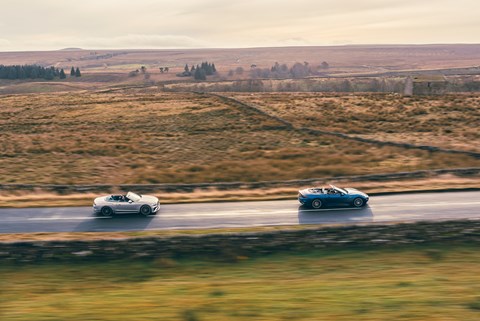
We push deeper into the middle of nowhere, roofs down, seats, neck warmers and steering wheels set to toasty, the sharp tang of screenwash wafting through chill cabins as Pirellis slip over roads smeared with salt and grime.
For such conceptually similar machines – both are front-engined, all-wheel-drive, four-seat droptops from prestige makers with over 100 years of heritage – their execution could barely be more different.
Assembled just a few hours away in Crewe and released with its coupe sibling back in June, the new Conti’s pretty much on home turf, strutting around in low-single-digit temperatures with its top off as though it’s the height of summer.
Like the previous model, this fourth generation is based on the MSB platform shared with the Porsche Panamera and appears very much evolutionary. Bentley, however, assures us 68 per cent of parts are new, the most obvious visual clue being single headlamps that nod to the S2 of 1959.
More significant is the Ultra Performance Hybrid powertrain. The only choice if you want a Conti, it replaces the recently discontinued W12 and adds 188bhp/332lb ft of electric thrust and a 25.9kWh battery to the previous ‘entry-level’ twin-turbocharged 4.0-litre V8.
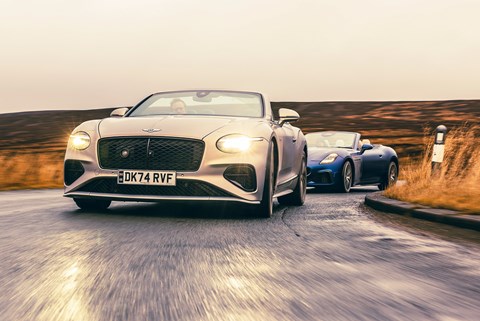
On paper, it’s almost all wins. An output of 771bhp makes a healthy leap over even the venerable W12 (739bhp in the ultra-rare Batur form), but economy shoots up from the Batur’s 20mpg to 26.6mpg and you can officially waft at up to 87mph and for as far as 50 miles totally emissions free.
Electrification is largely responsible for making this V8 over 400kg portlier than the Batur W12 (2636kg!) but throttle response is lag-free, the rich, bassy soundtrack is Bentley through and through, and this is tidal, gravitational performance of such magnitude I’d swear it makes the world rotate more swiftly. W12? Forgotten in the time it takes to reach 5000rpm.
Cost you, though. The Bentley bases from £259,500, with our example bumped to £311,455 mostly thanks to Extreme Silver paint (£9085) and its First Edition specification (£31,430). The latter includes massage seats, an infotainment screen that twizzles like a pig on a spit and some driver-assist tech you might assume was standard.
It makes the new Maserati look a snip at £169,585, with our test car tickled to £187,435 mostly thanks to £6960 of driver-assist gizmos and £3360 of Sonus 16-speaker hi-fi.
Design might again be distinctly evolutionary, but that rather underplays the fact Maserati has invested in a clean-sheet approach for its GranTurismo coupe and GranCabrio twins – probably for the best given the previous-generation convertible lived almost a decade and ended production in 2019.
Besides, offering a choice of a full electric version (the Folgore) or the entirely petrol Trofeo on one platform with only relatively minor changes necessitated a fresh architecture, the resulting head-scratching yielding a new body wrought predominantly from aluminium.
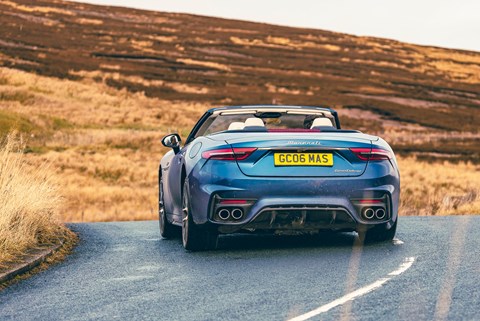
We’re driving the Trofeo, which combines Maserati’s Nettuno 3.0-litre twin-turbo V6 with an eight-speed auto gearbox and all-wheel drive. It’s a nicely balanced package, with the engine pushed far back in the nose and a front differential positioned so the wet-sumped engine can drop as low as possible, even if there’s no transaxle here.
It’s rapid too. The Nettuno’s 542bhp and 480lb ft might fall way short of the Bentley’s headlines, but so does its 1895kg kerbweight, meaning it loses out by just 6bhp in the power-to-weight stakes. (At 100kg heavier than the GranTurismo, it also carries far less of a penalty over its coupe sibling than the Bentley.)
On the road, the Maserati compounds that advantage by feeling far fleeter than its chunky kerbweight suggests, thanks to snappy steering, sparky surges of performance and gearshifts like hand claps. The umbilical cord of Ferrari might have long been cut since the last model with its Maranello-made V8, but that alacrity lives on.
The evening before, I take the Bentley north from CAR’s East Midlands base to meet the others in Catterick, North Yorkshire, easing down into an imperious kind of sports command driving position on indulgently comfortable chairs.
Much impresses in this sumptuous cabin, including gorgeously supple ‘Brunel’ leather and glossy carbonfibre trim, but quality falters here and there, most visibly with a bank of plastic switches in the centre console – I’ve used more premium-feeling ATMs. That the infotainment is so obviously lifted from Audi and not in its first flush of youth might also rankle, but it works just fine.
Leave the GTC in Comfort or ‘B’ for Bentley mode and – provided the battery is sufficiently topped – you slip away serenely, a perfect match for the glide of two-chamber air springs and dual-valve dampers. I manage 39 miles at an average of 64mph in zero-emissions mode, delighted to carbon-offset our impending profligacy.
Switch to Sport and the V8 fires with a distant thud, like an explosive detonated underwater. Performance is towering, but it’s more satisfying to lean into midrange muscle in manual mode than to let the dual-clutch transmission kick down in a distinctly two-stage process and send revs sky high.
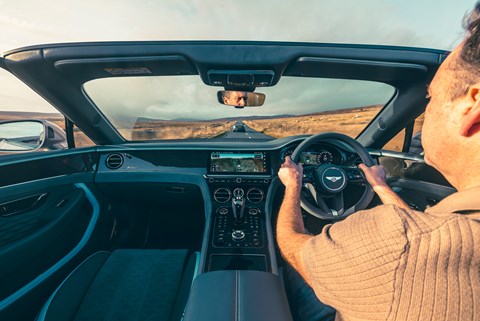
With massage seats working my back like a rolling pin eased over dough, this is a soothing way to while away the evening journey to Catterick, even if the seven-bow insulated hood could be quieter still.
Next morning I swap into the Maserati. Parked under street lighting it looks gorgeous, its low, pouty nose and long bonnet flowing into seductive curves. Like the Bentley, its hood preserves the coupe’s taut silhouette when raised, and adds welcome ‘off-the-shoulder’ appeal when stowed.
Climb in and the cockpit immediately sets the tone for a more sporting experience, with seats that drop lower and have firmer bases, and a cabin that’s less plush in feel and materials but which envelops its driver in a more purposeful manner than the Bentley.
Most redolent of Ferrari are large aluminium shift paddles fixed to the steering column, and a rotary drive-mode controller positioned at four o’clock on the steering wheel – without glancing from the road you can scroll through Comfort, GT, Sport and Corsa settings, and independently adjust suspension stiffness with a press.
Infotainment is somewhat less intuitive, with everything from stability control to roof operation condensed on a lower screen as busy as a Monopoly board, while the upper screen is a reach away, clearly configured for left-hand drive and often hard to fathom on the move.
The GranCabrio starts with a gruffness quite distinct from both the buttery Bentley and the trumpet fanfare of its predecessor’s V8, then short-shifts up the ’box as quickly as possible when left in gentler Comfort and GT modes. Around town this makes revs fall to 1500rpm and powertrain vibrations fizz through the structure.
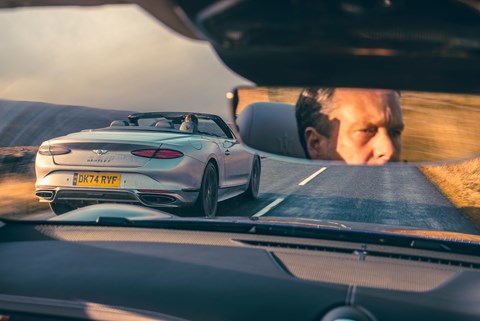
There’s also more road noise in the Maserati, and its secondary ride is pretty excitable too. The Maser’s roof drops faster, though, requiring just 14 seconds at up to 32mph (the Bentley requires 19 seconds up to 30mph) and better damps down noise at higher speeds, plus there’s actually more space in its rear seats.
Both have boots so tiny it’s best to pack light and swallow those room-service laundry charges. (The Bentley’s is compromised by the hybrid battery and mostly filled by its charging cable.)
We thread north and then west onto the A66 in darkness, our adaptive LED headlights picking out snow poles at the roadside and dimming around lorries taking a battering in this windswept buzz-cut of a landscape.
I switch the Maserati to Sport mode, swapping from the more muted Comfort and GT calibrations to bring more pep to the throttle and extra pop to the gearshifts. When I soften its damping, the GranCabrio’s abundant energy is complemented by some proper gran-turismo chops. Lovely. But it’s on minor roads further north, where Cumbria butts heads with County Durham, that the Italian car’s strengths come into focus.
Steering response ramps up immediately off-centre, the front end both sweeps in quickly and bites cleanly, and the brake pedal is drawn tight for heightened response. Perhaps most impressive is just how well the rear axle copes with the punchy direction changes, settling in one solid movement where similarly speedy reactions can upset a less well sorted chassis.
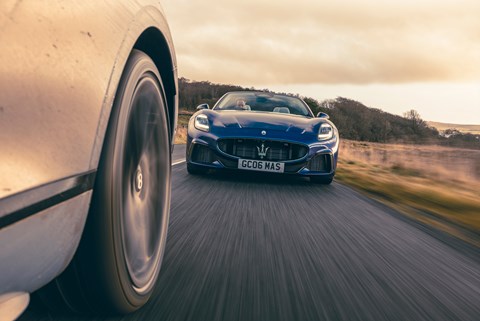
That the Maserati feels the wieldier, more compact machine on test despite being longer and only a fraction narrower is surely some kind of Modenese witchcraft.
Like the Bentley, the Maserati is most satisfying when worked in the meat of its midrange, but it’s less linear, with more of a burst of energy that adds a sense of abundant speed and heightens the perception of lightness.
There is, however, a brief pause as the turbochargers hit snooze, and a bagginess to the delivery despite otherwise sparky responses that I can’t quite put my finger on at first. Then one of the other testers nails it: ‘Heavy flywheel: makes it feel like the engine’s running on after you back off.’
As the road writhes along a valley, so the long primary strides of the Maserati’s Comfort suspension start to become a little loose. Sport quells the unwanted motion, firming the dampers and slightly lowering the ride height, and the Maser starts to move as a single piece. Even a quick sequence of direction changes can’t flummox it.
Maybe it’s the slinky look, the heritage or simply how fluidly it drives, but I keep forgetting the GranCabrio sends power to both ⊲ axles, meaning I baby it with more tentative throttle squeezes. Yet driven with the abandon of an unbranded courier van it is amazingly capable point-to-point, combining pronounced rear bias with trustworthy traction that can be teased out of shape if you sweet-talk it.
The Bentley always feels more imperious, but it can certainly step up when you push it harder over demanding roads. Compared with the last W12 Conti I drove back in 2019 there’s, well, no comparison, but Bentley added even more rear bias and rear-wheel steering to that car for 2021, and the new model builds on those foundations with a lighter V8 over the nose and lithium-ion ballast in the tail.

Extra weight is never good, but in this case it does endow a front-engined GT with a rear-biased weight distribution for the first time in Conti history, if by a whisker at 49:51.
The steering is nicely weighted, far more responsive and keener to turn than the rather sleepy previous set-up of that 2019 W12, while rear-steer introduces a level of agility that’s hard to square with the stately dimensions, plus the body control is unflappable.
In fact, it’s the body control and compliance that make this car so capable point-to-point, thanks to its air springs and adaptive dampers, yes, but also active roll control that helps keep all four tyres’ contact patches in touch with the ground and quells weight transfer. It is remarkably composed for a heavy car, even when tossed about.
The most aggressive suspension setting is usable on the road, too, though up here the compliance of ‘B’ for Bentley mode works best.
But dig deeper into its talents and the chassis is surprisingly malleable, with the powertrain’s outrageous muscle and instant response letting you squeeze it into all sorts of shapes. Let loose and it rips like a Bullingdon Club riot.
Only the brakes come in for criticism, as even with 10-piston front calipers, stopping power could be better. Plus the way the pedal pre-emptively sucks itself away from your foot in certain situations is a tad unsettling.
We climb up to the roof of the Pennines at dusk, before pulling over to survey a landscape crumpled like folds of flesh and largely unchanged from when Bentley and Maserati first started producing cars over a century ago.
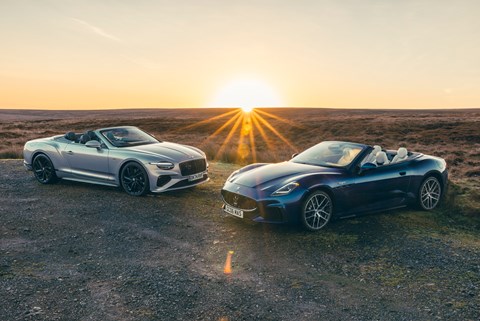
We swap notes and pick favourites, but ultimately it’s a little disingenuous to choose a winner from two cars so disparate in execution and so distant in price. The Bentley puts its focus firmly on all-round refinement with a surprising side of driver involvement, where the Maserati has a distinctly more sporting focus. As a daily driver the Bentley is best. For a great road I’d jump in the Maser.
Such ostentatious convertibles might be entirely out of kilter with the ruggedness of this corner of England, but prove to be enjoyable and surprisingly capable ways of exploring it all the same.